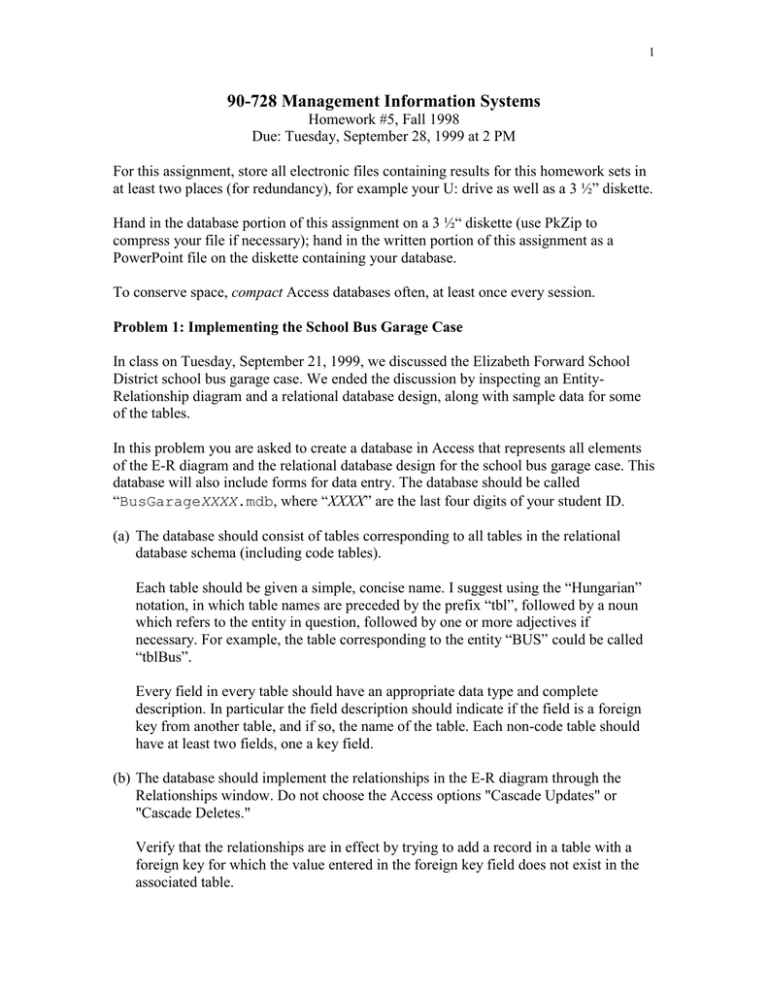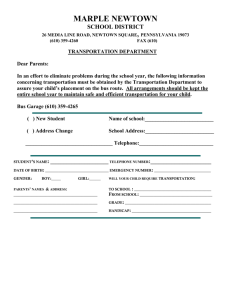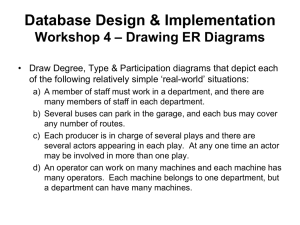90-728 Management Information Systems
advertisement

1 90-728 Management Information Systems Homework #5, Fall 1998 Due: Tuesday, September 28, 1999 at 2 PM For this assignment, store all electronic files containing results for this homework sets in at least two places (for redundancy), for example your U: drive as well as a 3 ½” diskette. Hand in the database portion of this assignment on a 3 ½“ diskette (use PkZip to compress your file if necessary); hand in the written portion of this assignment as a PowerPoint file on the diskette containing your database. To conserve space, compact Access databases often, at least once every session. Problem 1: Implementing the School Bus Garage Case In class on Tuesday, September 21, 1999, we discussed the Elizabeth Forward School District school bus garage case. We ended the discussion by inspecting an EntityRelationship diagram and a relational database design, along with sample data for some of the tables. In this problem you are asked to create a database in Access that represents all elements of the E-R diagram and the relational database design for the school bus garage case. This database will also include forms for data entry. The database should be called “BusGarageXXXX.mdb, where “XXXX” are the last four digits of your student ID. (a) The database should consist of tables corresponding to all tables in the relational database schema (including code tables). Each table should be given a simple, concise name. I suggest using the “Hungarian” notation, in which table names are preceded by the prefix “tbl”, followed by a noun which refers to the entity in question, followed by one or more adjectives if necessary. For example, the table corresponding to the entity “BUS” could be called “tblBus”. Every field in every table should have an appropriate data type and complete description. In particular the field description should indicate if the field is a foreign key from another table, and if so, the name of the table. Each non-code table should have at least two fields, one a key field. (b) The database should implement the relationships in the E-R diagram through the Relationships window. Do not choose the Access options "Cascade Updates" or "Cascade Deletes." Verify that the relationships are in effect by trying to add a record in a table with a foreign key for which the value entered in the foreign key field does not exist in the associated table. 2 (c) The database should have forms for data entry and inspection that correspond to every non-code table. Conventions for the forms are as follows: All text fields that display data are left-justified; All numeric fields that display data are right-justified; All heading fields are center-justified; All numeric fields are formatted so as to include thousands’ commas and two decimal places. Currency fields should be formatted as such; All fields intended as “Comment” or “Description” should be formatted as “Memo” Each form should have a descriptive caption, along the lines of: “Elizabeth Forward School District – [specific form type]”; Each form should have a simple but descriptive name. Again, I recommend “Hungarian” notation, where a form name is prefixed by “frm” and followed by a noun indicating the entity or action of interest and, optionally, one or more adjectives. Date fields should have validation rules and text which prevent entering dates later than today; Numeric fields should have validation rules and text that prevent entering negative values; Forms should be well-proportioned: not too much blank space on the sides or on the top and bottom; Every field on a form corresponding to a foreign key from a non-code table should be implemented as a combo box, with headings and enough space to display at least two columns from the table; Every field on a form which refers to a code table should be implemented as a combo box, with exactly one column from the code table and no headings; The following tables should be implemented on forms that have tabular design and have the “Default View” property set to “Continuous Forms”: tblBus, tblEmployee, tblGasFillUp, tblPart, tblOilCheck, tblGasTankLevel. The pairs of tables tblRepair and tblRPLink, and tblInspection and tblInspectionTypeLink, should be implemented in a form-subform arrangement. There should be no redundant data on the forms, and both derived attributes listed in the solution to the bus garage case must appear on these forms. (d) Your database should contain data for all tables as contained in the case solution handed out in class and in the spreadsheet r:\academic\90728\BusGarageData99.xls. Data may be transferred from the spreadsheet to the Access database in two ways: In Excel, select and copy all cells in the current worksheet (e.g. the worksheet corresponding to the BUS entity); paste the copied cells to a new Access table in datasheet view; delete the first row (column headers from the worksheet) 3 In Access, select the Tables tab; select New, choose Import Table from the list of options, navigate to the location of BusGarageData99.xls, and follow the directions provided by Access to import Excel worksheets. (e) You should test your database by entering new data through the forms and observing values of calculated fields. (f) Switchboards or other measures to guide the user about the different forms in the Bus Garage application are not necessary. (g) No queries or reports are required for the Bus Garage application. Problem 2: A Decision-Tree Diagram for the Health Inspections Problem Recall the Health Inspections problem of Homework #4. Here, you should: List all important decision points (HINT: the problem description includes as an inspection outcome the immediate revocation of an establishment); Create an appropriate decision tree; Notate each branch as follows: text above the branch designates the outcome of a decision point; text below the branch designates the applicable permit code (if one exists).





